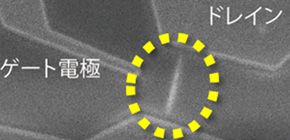
Mysterious behavior of quantum liquid elucidated, a world first
Moving toward unexplored territory in physics
Graduate School of Science, Osaka University – KOBAYASHI Kensuke (Professor), Meydi Ferrier (Specially Appointed Researcher; Lecturer at Université Paris-Sud 11, Orsay), ARAKAWA Tomonori (Assistant Professor), HATA Tokuro (Graduate Student), FUJIWARA Ryo (Graduate Student)
Graduate School of Science, Osaka City University -- OGURI Akira (Professor)
The Institute for Solid State Physics, The University of Tokyo -- SAKANO Rui (Assistant Professor)
In cooperation with researchers from Osaka City University and The University of Tokyo, researchers at Osaka University, through the highest level of precise measurement of current fluctuations in quantum liquids in artificial atoms created by fine processing technology, succeeded in elucidating theoretically-predicted behavior of quantum liquid in a non-equilibrium state.
Quantum liquids are macroscopic ensembles of interacting particles dense enough for quantum statistics to manifest itself. For fermions, it is known that, around equilibrium, all the quantum liquids can be universally described within a single theory, so called Landau Fermi liquid theory. The idea is that they can be treated as an ensemble of free “quasi-particles”. This conceptual framework has been applied to many physical systems, such as liquid helium 3, normal metals, heavy fermions, neutron stars, and cold gases, where their properties in the linear-response regime have been successfully described by the theory. However, non-equilibrium properties beyond this regime have still to be established and remain a key issue of many-body physics.
Here, we show a precise experimental demonstration of Landau Fermi-liquid theory extended to the non-equilibrium regime in a 0-D system. Combining transport and sensitive current noise measurements, we have identified the SU(2) and SU(4) symmetries of quantum liquid in a carbon nanotube tuned in the Kondo regime. We find that, while the electronic transport is well described by the free quasi-particle picture around equilibrium just as the Fermi liquid theory tells us, a two-particle scattering process due to residual interaction shows up in the non-equilibrium regime. Our result, in perfect agreement with theory, provides a strong quantitative experimental background for further developments of the many-body physics. Moreover, we discovered a new scaling law for the effective charge, signaling as-yet-unknown universality in the non-equilibrium regime.
This achievement will open up a new way to explore quantum many-body physics through fluctuations, which stands on firm ground even out of equilibrium beyond the conventional Landau Fermi liquid theory. The newly discovered universality would trigger a vast theoretical effort.
Abstract
Interacting quantum many-body systems constitute a fascinating research field because they form quantum liquids with remarkable properties and universal behaviour. In fermionic systems, such quantum liquids are realized in helium-3 liquid, heavy fermion systems, neutron stars and cold gases. Their properties in the linear-response regime have been successfully described by the theory of Fermi liquids. The idea is that they behave as an ensemble of non-interacting ‘quasi-particles ’ . However, non-equilibrium properties have still to be established and remain a key issue of many-body physics. Here, we show a precise experimental demonstration of Landau Fermi liquid theory extended to the non-equilibrium regime in a zero-dimensional system. Combining transport and ultra-sensitive current noise measurements, we have unambiguously identified the SU(2) and SU(4) symmetries of a quantum liquid in a carbon nanotube tuned in the universal Kondo regime. Whereas the free quasi-particle picture is found valid around equilibrium, an enhancement of the current fluctuations is detected out of equilibrium and perfectly explained by an effective charge induced by the residual interaction between quasi-particles. Moreover, an as-yet-unknown scaling law for the effective charge is discovered, suggesting a new non-equilibrium universality. Our method paves a new way to explore the exotic nature of quantum liquids out of equilibrium through their fluctuations in a wide variety of physical systems.
Figure 1 (left) In a single particle system, the behavior of the particle is well understood by solving the Schrodinger equation. Here the particle possesses wave nature characterized by the de Broglie wave length. (right) In a many particle system, on the other hand, the particles interact each other in a quantum mechanical way and behave as if they are "liquid". This is called quantum liquid whose properties are very different from that of the single particle case.
Figure 2 (a) Sample and experimental set-up. SEM image of a carbon nanotube connected to metallic leads on a silicon wafer. It is connected to the current and noise measurement set-up through a resonant circuit fixed on the mixing amber of the dilution fridge. The quantum dot made of a single carbon nanotube is marked by the yellow dashed curve. (b) Kondo excess current noise as a function of backscattering current for the same fields. The effective charge e*/e is extracted from the slope at low current to be 1.7. (c) Effective charge as a function of the normalized temperature and magnetic field in a semi-log plot. Both can be described by the same line, which is a signature of an as-yet-unknown logarithmic scaling law for e*/e.
To learn more about this research, please view the full research report entitled “ Universality of Non-equilibrium Fluctuations in Strongly Correlated Quantum Liquids ” at this page of the Nature Physics website.
Related link

